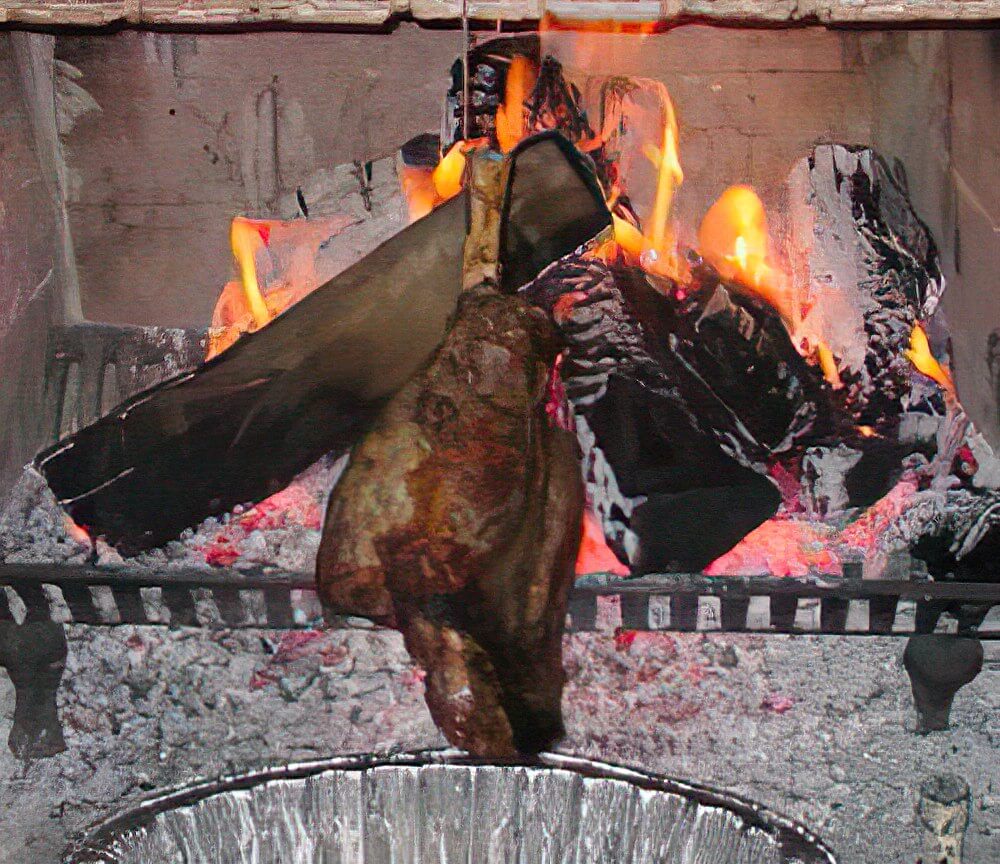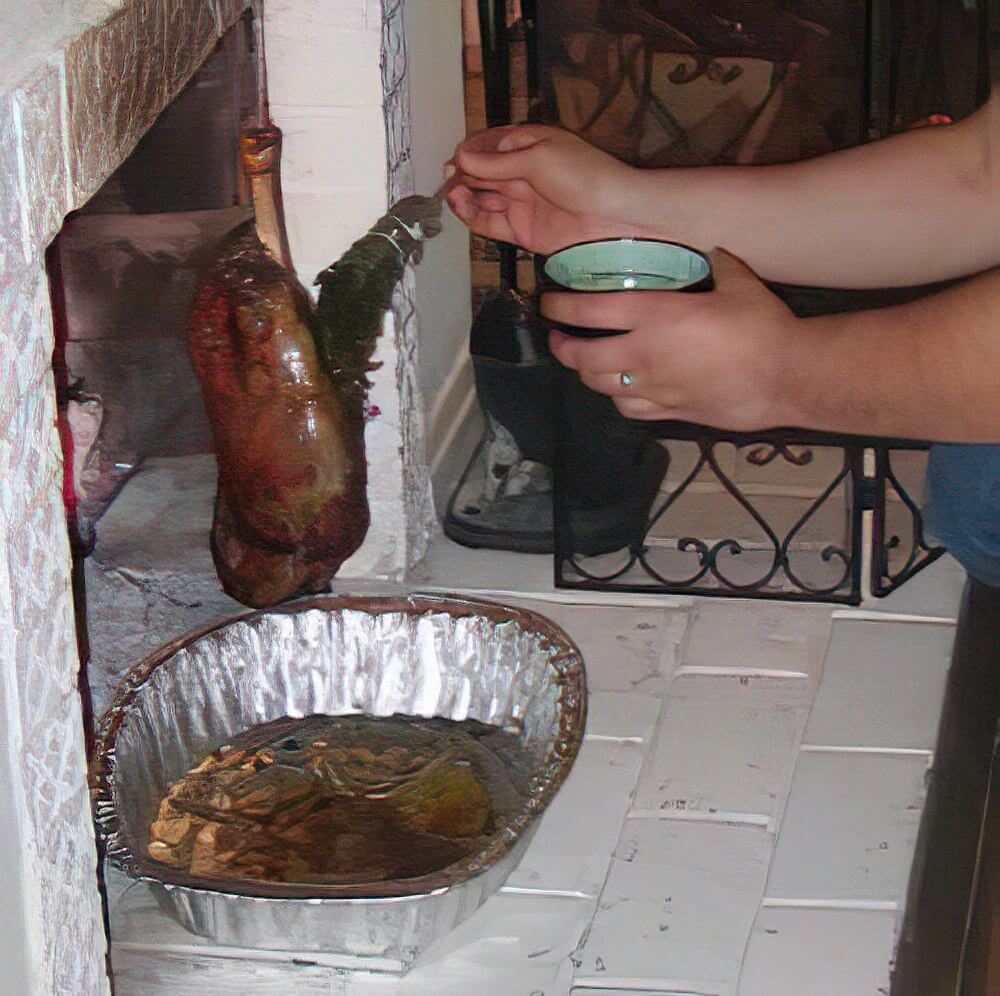During the fall and winter months, there is nothing like hearth cooking. Relaxing by the warm, crackling fire, sipping a glass of wine, while you watch your food hypnotically turn in front of the flames, slowly cooking it to juicy perfection. Fireplace cooking may seem adventurous but it has been around for centuries and it is a great way to cook food and its really not that hard!
Fireplace string-turned roasting is one of my favorite types of hearth cooking. The meat hangs in front of the hot fire, slowly spinning on its own. This acts like a rotisserie, ensuring your meat is evenly cooked. It works wonderfully and you don’t need any fancy equipment like a fireplace grill or fireplace rotisserie.
What can I string turn in the fireplace?

- The all-time classic string-turned recipe for hearth cooking is string-turned leg of lamb. It is a recipe that is very Provençal, originating from the south of France. The gamey, rustic flavors of the tender lamb meat are perfect cooked slowly in front of a roaring fire.
- The classic hearth cooking string-turned leg of lamb inspired me to try other things in front of the fireplace! My other favorite now is string-turned roast chicken. I usually use a French ginger-tarragon marinade and serve this warming meal with a side dish of squash puree which is a perfect pairing for my taste.
- But why stop there? If you get creative, there are plenty of other things you can string-turn in your fireplace. Experiment with different meats and different marinades. For instance, substitute other poultry for chicken. Guinea hens, pheasant, and duck can all be cooked by string-turned hearth cooking too. I’d go for more rustic, strongly flavored herbs though…thyme, savory, oregano, all those great things that grow wild on the southern French hillsides. You can even cook smaller game birds and poultry like squab, game hens, poussin, or quail. Just get creative with your string trussing and you can even hang several small birds in parallel. Just remember that the smaller the bird, the faster it will cook! Try getting creative and figure out other things you can secure on a string a slow-cook in front of your fire…leg of goat or a tri-tip roast maybe?
Some tips for hearth cooking string-turned roasts:

- Build a good fire – With hearth cooking, before even thinking of hanging up your string-turned roast, make sure you’ve got a good, hot, roaring fire going! The biggest mistake you can make is putting your roast on too early. If you haven’t noticed, the most heat from your fire comes from the glowing red wood embers that develop at the bottom as your fire burns. The flames themselves don’t give off as much heat. When you first start up your fire, all you have is heat from flames, no embers yet! Wait, wait, and then wait again! You want to burn through several large logs before even considering adding your food. You should see a pile of glowing embers at the base of your fire. This is your “core of heat”. Then continue feeding it by adding new wood on top. As it burns, it will fall down to add to the hot embers. Only then should you start cooking. It should be uncomfortably hot holding your hand about a foot in front of the fire. In my experience, this whole process of getting the fire ready usually takes over an hour, and sometimes considerably more. Then continue fueling your fire by occasionally adding fresh wood on top and towards the back of your fire.
- Cook appropriately sized roasts – First of all, for string-turned hearth cooking you want something that is not too heavy to hand on a hook in front of your fire. It would be a shame if your roast broke the string! If you are cooking meat that you want to leave somewhat pink in the middle, like lamb or beef, the size is not as critical because you don’t need it to cook all the way through. However, for roasts that do require thorough cooking all the way through, like chicken, you want to limit the size of your roast so that the inside will be able to cook before the outside is burnt to a crisp! String-turning a turkey won’t work because after the 3 or 4 hours it takes to cook through to the middle, the skin and outer meat would all be dried out, black and crispy.
Therefore, for chickens and other birds I like to limit it to about 4 pounds or less. For leg of lamb, you can go up to 6 pounds, but again, I tend to prefer the slightly smaller ones.
- Secure your string sturdily – You want your hook and string to be sturdy and to hold your spinning roast for the full cooking time without breaking. First of all, find a good secure place above your fireplace to secure a hook. A wooden mantle or other structural piece is ideal. Do not just screw your hook into drywall as this will easily pull out! Secondly, use heavy duty twine. Good kitchen twine you use for trussing should do fine.
- Wet your string – I always wet the part of string exposed to the fire occasionally as it cooks. This helps prevent the string from drying out and breaking. It also helps prevent it catching on fire! I’ve never had either happen but it is best to try to avoid these before you experience them. If your string does break, don’t panic. Simply pick up your roast (it should have fallen into your drip pan), take it to the kitchen and carefully re-string it.

- Marinate and Baste – Most of these roasts benefit from some time marinating beforehand to add flavor and seal in juices. Also, don’t forget to baste your roast occasionally as it cooks to add more flavor, keep your roast moist and to help develop a nice golden glaze of caramelized flavor on the surface.
- Let your meat rest – Just as with oven roasts or grilling, letting a large cut of meat rest after hearth cooking is very important. It gives a chance for the heat and juices inside your roast to redistribute and equilibrate. This means more evenly cooked and juicy pieces of meat on your plate. So take your time. After your fireplace cooking roast is just done, remove it from the fireplace, place it on a platter and cover with aluminum foil (or other heat proof top). Let it sit for at least 15 minutes, but even longer for larger roasts like leg of lamb or a large chicken. Only then should you uncover it and carve as usual.
There you go! Go experiment and have fun with your hearth cooking. String-turned roasts are one of the easiest types of fireplace cooking and you don’t have to buy and special equipment. So go fire up your fireplace and enjoy!
For all sorts of the great grill and fire pit recipes, see our Grill Recipes page. It includes fireplace cooking ideas including a string-turned leg of lamb recipe and a string-turned roast chicken recipe.
Hi, I’m Adam and I’m a HUGE fan of Food and Cooking.
Do you enjoy grilling sessions with your family while staring at the beautiful fire pit flames?
Flame Gorilla is the site to learn how to have that perfect backyard experience.

